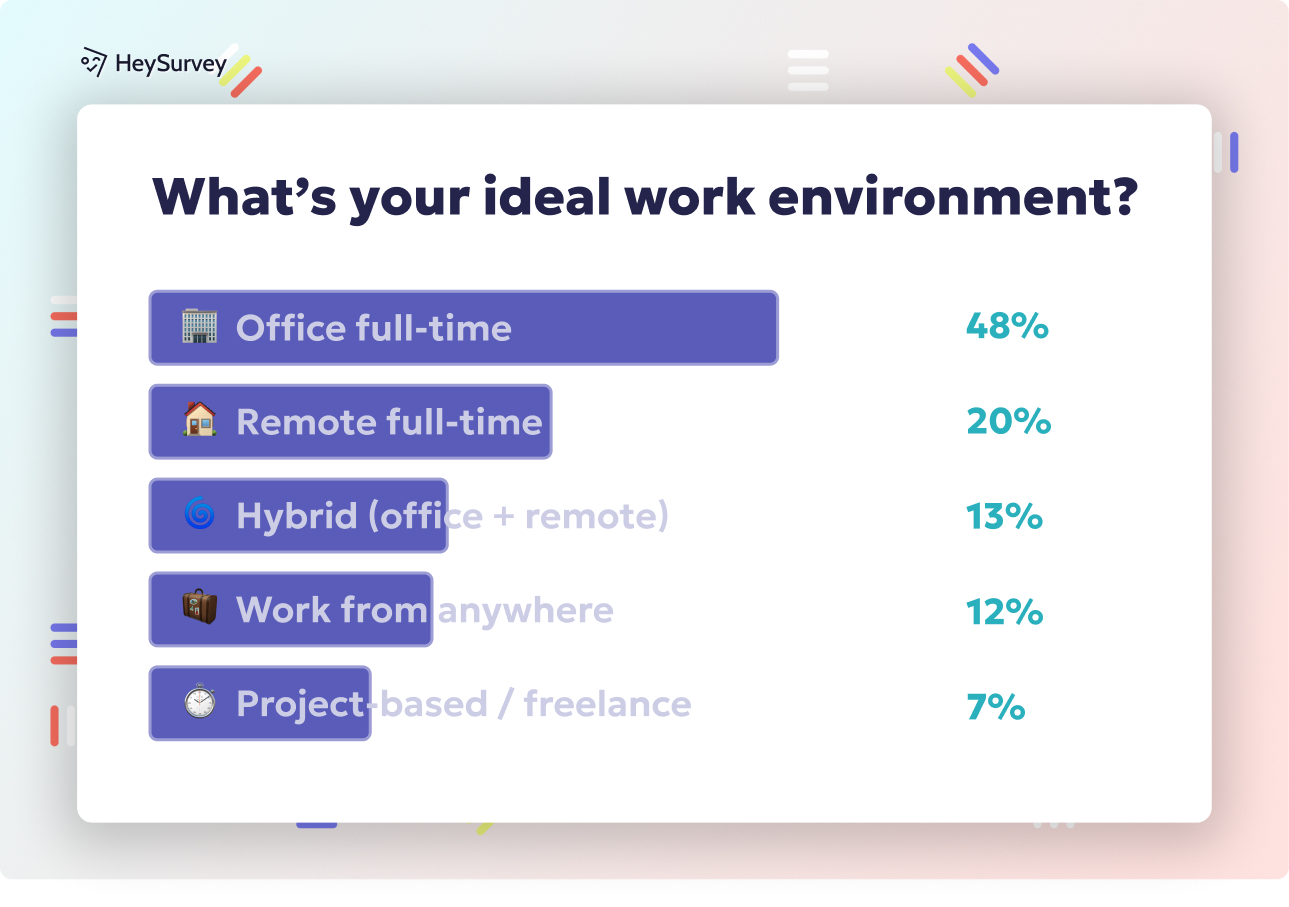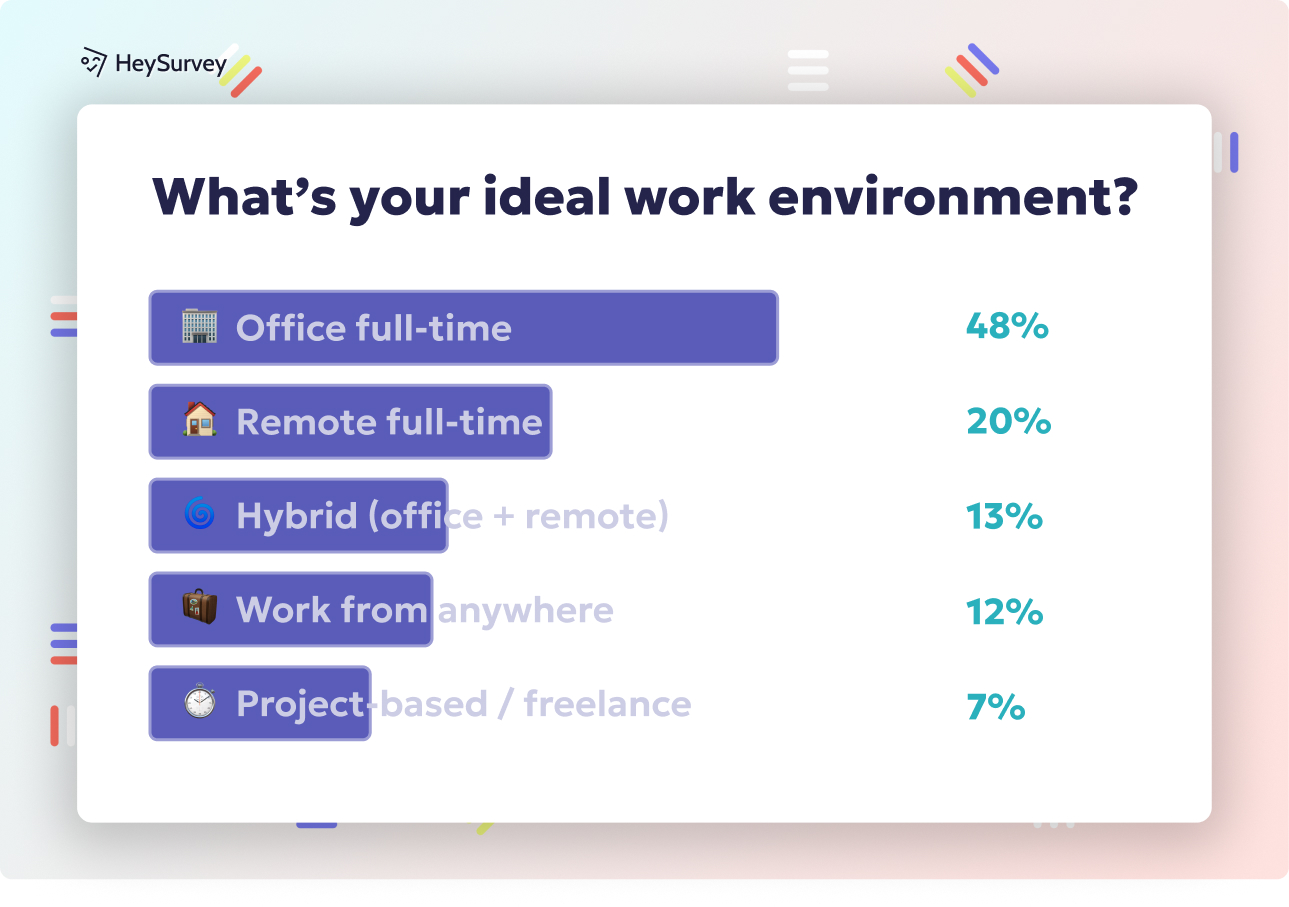25 Quality of Hire Survey Questions to Measure New-Hire Success
Discover 30 expert quality of hire survey questions across 6 surveys to accurately measure new-hire success and boost talent analytics results.
Quality of Hire Survey Questions: The Complete Guide to Measuring New-Hire Success
Quality of hire is a metric that evaluates the effectiveness of your recruitment process by assessing the performance and impact of new employees. In the realm of talent analytics, understanding this metric is crucial for refining hiring strategies and enhancing organizational performance.
To gain a comprehensive understanding of hire quality, it's essential to employ a multifaceted approach. This involves utilizing six distinct survey types, each designed to capture unique insights at various stages of the employee lifecycle. By implementing these surveys, organizations can achieve a 360° view of new-hire success.
The benefits of measuring quality of hire are substantial. By effectively assessing this metric, companies can experience reduced turnover, higher productivity, and better cultural alignment. These outcomes not only enhance operational efficiency but also contribute to a more cohesive and engaged workforce.
Introduction: Why & When to Use Quality of Hire Surveys
Relying solely on performance reviews can create blind spots in understanding a new hire's true impact. Traditional reviews often focus on past performance, overlooking the initial adaptation phase and the employee's evolving contributions.
To address this, it's beneficial to deploy specific surveys at key milestones in the employee lifecycle:
- Onboarding Day 7: Capture early impressions and identify immediate training needs.
- Day 30: Assess initial integration and role clarity.
- Day 90: Evaluate performance and cultural fit.
- Annual: Review long-term contributions and growth.
- Exit: Understand reasons for departure and gather feedback for improvement.
For more insights on gathering feedback during the onboarding process, consider exploring our employee onboarding surveys.
Implementing structured quality of hire surveys at key milestones enhances understanding of new hires' impact and informs improvement strategies. Source

Creating a quality of hire survey with HeySurvey is a breeze—even if you’re brand new to the platform. Follow these simple steps to get your survey up and running quickly:
Step 1: Create a New Survey
Head over to HeySurvey and click Create New Survey. You can start from scratch or save time by opening one of our pre-built templates tailored for quality of hire surveys. This sets the foundation for your feedback collection and gets you ready to add those all-important questions.
Step 2: Add Questions
Use the Add Question button to insert survey questions—choose from scales, multiple-choice, or open text to match your needs. You can easily customize each question’s wording and format to match the sample questions from our article, like “On a scale of 1–10, how confident do you feel performing your core job tasks?” Don’t forget to mark must-answers as required, so you don’t miss vital feedback!
Step 3: Publish Your Survey
Once your questions are in place, hit Preview to see what your respondents will see. Feeling good? Click Publish. You’ll get a shareable link or embed code to start collecting responses. Just a heads-up: publishing requires a free HeySurvey account to track results securely.
Bonus Step: Apply Branding
Make your survey truly yours by uploading your company logo and choosing your brand’s colors through the Designer Sidebar. A touch of branding makes your survey feel professional and aligned with your identity.
Bonus Step: Define Survey Settings
Open the Settings Panel to schedule availability, set response limits, or set a custom thank-you redirect page. Control who takes your survey and when for maximum impact.
Bonus Step: Add Branching Logic
For advanced customization, use HeySurvey’s branching feature to skip respondents ahead or dive into relevant follow-up questions based on their answers. This keeps your survey smart and respectful of participants’ time.
Ready to create your own survey? Just click the button below to open a Quality of Hire Survey Template and start customizing right away!
New-Hire Self-Assessment Survey
Why & When to Use This Survey
Administering this survey on Day 30 allows new hires to reflect on their initial experiences and self-assess their confidence in performing core job tasks. This early feedback is invaluable for identifying training gaps and addressing potential performance issues before they escalate.
5 Sample Questions to Ask
- On a scale of 1–10, how confident do you feel performing your core job tasks?
- Which onboarding resources have been most helpful so far?
- Do you understand how your role success will be measured?
- What obstacles, if any, are hindering your productivity?
- How aligned do you feel with our company values?
Content Tips
- Emphasize first-person language: Encourage reflection by using "I" and "my" in questions.
- Use Likert scales plus one open-text box: This combination allows for both quantitative analysis and qualitative insights.
Standardizing qualitative data collection in new hire surveys by incorporating ranked elements alongside open-ended questions enhances the measurement of Quality of Hire. (crosschq.com)
Hiring Manager Assessment Survey
Why & When to Use This Survey
Conduct this survey on Day 45 and again on Day 90 to gather the hiring manager's perspective on the new hire's fit, ramp-up speed, and potential. This feedback is crucial for understanding how well the new employee integrates into the team and meets performance expectations.
5 Sample Questions to Ask
- How quickly did the new hire reach expected productivity benchmarks?
- What unique strengths has the new hire demonstrated?
- Which competencies require additional development?
- How well does the new hire collaborate with the team?
- Would you rehire this candidate today? Why or why not?
Content Tips
- Encourage numerical ratings plus comment fields: This approach blends quantitative data with qualitative feedback, providing a more comprehensive assessment.
90-Day Performance & Potential Survey
Why & When to Use This Survey
Conduct this survey at the 90-day milestone to validate the long-term hiring ROI. It's ideal for correlating early survey data with actual performance KPIs, offering a clear picture of the new hire's impact on the organization.
5 Sample Questions to Ask
- What measurable goals has the hire achieved since onboarding?
- Rate the new hire’s learning agility on a 1–5 scale.
- How effectively does the hire prioritize tasks?
- Is the hire on track for promotion within anticipated timelines?
- What additional support would accelerate the hire’s growth?
Content Tips
- Integrate with HRIS data: Combining survey responses with HRIS data (e.g., time-to-productivity, sales numbers) strengthens the credibility of the survey findings.
Conducting a 90-day performance review with targeted questions helps assess new hires' integration, performance, and alignment with company goals, enhancing long-term hiring ROI. (aihr.com)
Peer & Team Feedback Survey
Why & When to Use This Survey
Deploy this survey after 60–90 days to capture collaboration, communication, and culture fit from the co-workers' perspective. Understanding peer feedback provides a holistic view of the new hire's integration and effectiveness within the team.
5 Sample Questions to Ask
- How effectively does the new hire communicate with the team?
- Describe a time the new hire contributed to team success.
- How open is the new hire to feedback?
- Rate the hire’s impact on team morale, 1–5.
- What one improvement would make working with this hire even better?
Content Tips
- Keep surveys anonymous: This encourages candid responses and honest feedback.
- Mix rating scales with short-answer prompts: This combination provides both quantitative data and qualitative insights.
Cultural Fit & Engagement Pulse Survey
Why & When to Use This Survey
Run this survey at Day 60 and semi-annually thereafter to gauge alignment with organizational values and engagement drivers. Regularly assessing cultural fit ensures that new hires are integrating well and remain engaged over time.
5 Sample Questions to Ask
- Which company value resonates most with you and why?
- Do you feel your work contributes to the company mission?
- How likely are you to recommend this company as a great place to work?
- Do you get sufficient recognition for your contributions?
- What could leadership do to improve your engagement?
Content Tips
- Benchmark scores against tenured employees: This helps identify assimilation gaps and areas for improvement.
Exit-Triggered Early Attrition Survey
Why & When to Use This Survey
Activate this survey if a new hire exits within the first 12 months to uncover root causes and refine future hiring criteria. Understanding the reasons behind early departures is crucial for improving retention strategies and hiring processes.
5 Sample Questions to Ask
- What primary factor influenced your decision to leave?
- Did the role meet the expectations set during the hiring process?
- How would you rate the support received from your manager?
- Which resources or changes might have encouraged you to stay?
- On a scale of 1–10, how accurately did the interview process portray our culture?
Content Tips
- Keep survey short (<10 mins): This maximizes completion rates during a sensitive time.
Best Practices: Dos & Don’ts for High-Impact Quality of Hire Surveys
Dos:
- Tie questions to specific competencies: This ensures relevance and clarity.
- Keep language plain: Avoid jargon to ensure understanding.
- Blend quantitative scales with open-ended items: This provides a balanced view.
- Time surveys to key milestones: This captures timely and relevant feedback.
- Close the feedback loop with visible action: Demonstrate that feedback leads to change.
Don’ts:
- Overload respondents: Keep surveys concise to maintain engagement.
- Use leading questions: Ensure neutrality to gather unbiased data.
- Send surveys without anonymity assurances: This can deter honest responses.
- Ignore mobile optimization: Ensure surveys are accessible on all devices.
- Analyze results in isolation: Contextualize data for meaningful insights.
By implementing these best practices, organizations can create effective quality of hire surveys that provide valuable insights into the hiring process and contribute to overall organizational success.
Related Hiring Survey Surveys

29 Hiring Manager Satisfaction Survey Questions to Boost Hiring
Discover 25 hiring manager satisfaction survey questions with expert tips to improve recruiter al...

